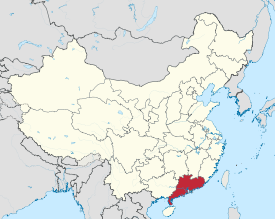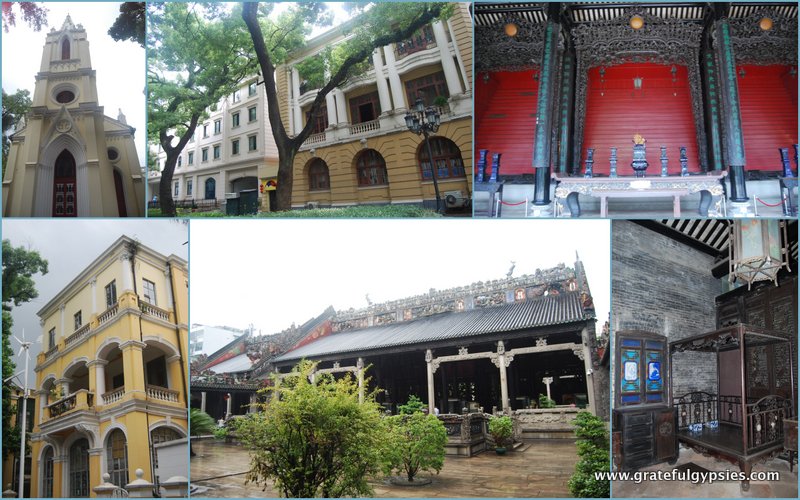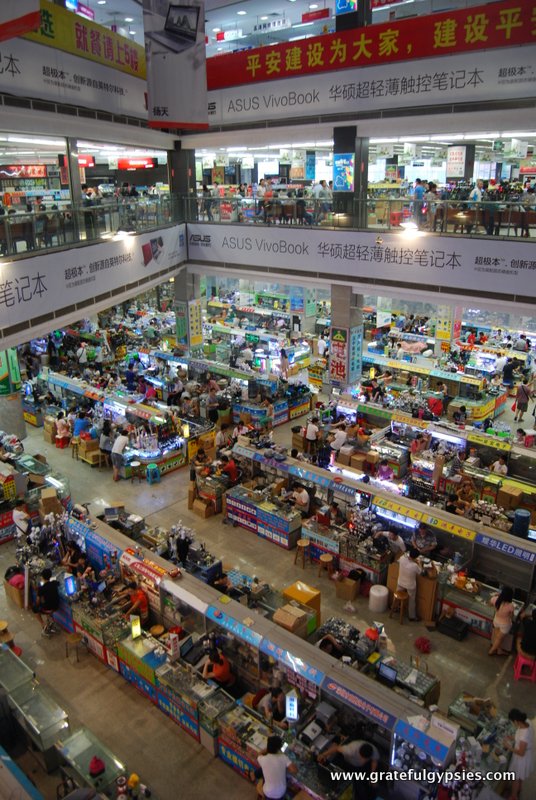Better Know a… Province (Guangdong) Posted by sasha on Oct 31, 2014 in Culture
Our long and winding journey around the Middle Kingdom continues as we visit one of the most famous regions of China, the province once known as Canton – Guangdong (广东 – guǎng dōng).
https://www.youtube.com/watch?v=86VG_p8u_Gw
A brief intro to Guangdong.
History
Due to its geographic location far away from the center of power in early China, this area was originally occupied by non-Han Chinese groups and enjoyed a high degree of autonomy. It’s believed that the “Hundred Yue” (百越 – bǎi yuè) – a collection of different Yue tribes – inhabited this land. This lasted until the unification of China under the emperor Qin Shihuang and the subsequent Qin Dynasty. In between the fall of the Qin and the start of the Han, modern day Guangdong, Guangxi, and Yunnan, along with part of what is now northern Vietnam, became the Nanyue Kingdom (南越 – nán yuè). During the Han Dynasty, the former kingdom was administered as Jiaozhi province. The region would go through many changes in following dynasties, changing its borders and name quite often until the current name was given during the Ming Dynasty.
Throughout the years, the demographics of Guangdong changed dramatically. Mass migration due to political turmoil brought millions of Han Chinese people from the north and central parts of the country to Guangdong. The population exploded, mostly with Han migrants, and the local people were eventually assimilated into Han culture.
The geography of Guangdong also helped the region grow as a major trading hub, giving Europe access to China. Macau, just south of Guangdong, even became the first European settlement in 1557 (Portuguese). The opium trade went directly through Guangzhou, and this led to the first of two Opium Wars between China and the UK/France. A humiliating defeat for China resulted in Hong Kong being ceded to the British.
There would be more war and chaos in Guangdong, starting with the Taiping Rebellion in 1850. Its leader, Hong Xiuquan, had visions that led him to believe he was the brother of Jesus. He led a rebellion against the Manchu Qing Dynasty, and it turned out to be one of the deadliest military conflicts ever. Later on, Sun Yat-sen (who was from Guangdong) would help end imperial China and usher in the short-lived Republic of China era with the Kuomintang (KMT).
https://www.youtube.com/watch?v=-ejYKNyA1nQ
In the past few decades, Guangdong has experienced rapid economic development, and it is now far and away the richest province in China.
Geography

Guangdong on the map.
Guangdong is the southernmost province on mainland China. It’s located down in the southeast, facing the South China Sea to the south along a 4,000+ km coastline. It also borders Fujian to the northeast, Hunan and Jiangxi to the north, Guangxi to the west, and both Hong Kong and Macau to the south. Part of Guangdong is included in the Pearl River Delta (珠江三角洲 – zhū jiāng sān jiǎo zhōu), the convergent point of three rivers: the East, North, and West. There are hundreds of small islands in the delta. In the north of the province, you’ll find part of the collective Nan Mountains (南岭 – nán lǐng) that separate the south from central China. The highest peak in Guangdong can be found at Shikengkong (石坑崆 – shí kēng kōng). Towering at 1,902 meters (1.18 miles), it’s known as the “Roof of Guangdong.” This is part of the Nanling National Forest Park, which also features waterfalls, canyons, and plenty of rolling hills. Guangdong is split up into twenty-one prefecture-level divisions – nineteen prefecture-level cities and two sub-provincial cities. These two cities – the capital Guangzhou and the SEZ Shenzhen – are two of the biggest and most important cities in China.
Climate
Much of the province has a humid subtropical climate, although some areas in the south are closer to a tropical climate. The average annual temperature of Guangdong is 22°C. Winters are short, warm, and relatively dry, while summers are long, incredibly humid, and very wet. Obviously, the year-round warm weather is a big draw for people who travel or move to the area. Guangdong gets a lot of rain though, especially in the summer months.
Population
Get an idea for the explosion of Guangdong’s population in this short video about a city called Shunde.
Guangdong recently surpassed Henan as China’s most populous province. In the 2010 census, the province recorded around 104 million residents – about 79 million permanent residents and the rest migrant workers who live there for at least half of the year. It is thanks to these “floating workers” that Guangdong became the most populous part of China. This means that almost 8% of the entire population of China lives in Guangdong. To put that into perspective, if Guangdong were a country, it would be in the Top 20. There are more people living there than the UK, France, or Germany. If you combined the populations of Texas, California, and New York (the three largest US states), you still wouldn’t equal Guangdong. Not surprisingly, almost all of the people here are Han Chinese, although there is a big subgroup of Cantonese people. You’ll also find some Teochew people in Chaoshan and Hakka people in many other regions. There are also small minority populations of Yao, Miao, She, Li, and Zhuang people.
Culture

Mmmm… dim sum.
It should come as no surprise that many people speak Cantonese throughout Guangdong province, although the millions of migrant workers from all over the country coming in to find work has diminished its role and Mandarin is the lingua franca in most places. Of course, Cantonese food (粤菜 – yuè cài) is everywhere in Guangdong, and it’s actually one of the “Four Great Traditions” of Chinese cuisine. No visit to Guangdong would be complete without a delicious meal of dim sum (点心 – diǎn xīn). Cantonese opera is also characteristic of the region, although it is less and less popular with the younger generation.
https://www.youtube.com/watch?v=XBK2AjBzoe8
Other groups such as the Teochew and Hakka have their own unique cultural identity – they speak different dialects, have their own style of cooking, and have different forms of music and entertainment. You might have to visit the regions where they predominantly live to experience their culture, as it won’t be easy to find in the mega-cities.
Famous Places
When a lot of people think of Guangdong province, they picture nothing but crowded cities and factories busy churning out cheap goods. While this is not an entirely inaccurate portrayal of the region, there’s much more to Guangdong and it is becoming a more popular tourist destination with every passing year. Most visitors to the province tend to visit the big cities of Guangzhou and/or Shenzhen, with a day trip or two thrown in to see a few other places of interest outside of the city.
In the capital of Guangzhou, you can visit quite a few historical sights, such as the Chen Clan Academy, Sun Yat-sen Memorial Hall, and the Xiguan Residence. You can also take a stroll around Shamian Island, a little slice of Europe in the middle of a huge Chinese city. Then there’s the new city, highlighted by the massive Canton Tower – the tallest structure in China.

A bit of sightseeing in Guangzhou.
As for Shenzhen, many people flock here to shop in the massive markets, hit the beach, and take in a few of the theme parks. The Splendid China park comes highly recommended; here you can tour models of villages from all over the country to learn about the various ethnic groups, see nearly 100 miniature models of famous landmarks, and watch an incredible evening performance. Of course, Shenzhen’s proximity to Hong Kong attracts many visitors as well, since flights to/from SZ tend to be much cheaper and the border crossing isn’t too difficult.

From a huge electronics market…

…to a mini-temple.
Other famous places in Guangdong include mountains (Mt. Sijiao and Mt. Danxia), lakes (Star Lake), plenty of parks, and the birthplace of Sun Yat-sen in Zhongshan.

Build vocabulary, practice pronunciation, and more with Transparent Language Online. Available anytime, anywhere, on any device.
About the Author: sasha
Sasha is an English teacher, writer, photographer, and videographer from the great state of Michigan. Upon graduating from Michigan State University, he moved to China and spent 5+ years living, working, studying, and traveling there. He also studied Indonesian Language & Culture in Bali for a year. He and his wife run the travel blog Grateful Gypsies, and they're currently trying the digital nomad lifestyle across Latin America.




Leave a comment: